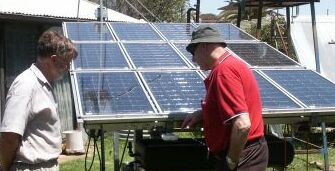|
|
|
|
|||
Desalination One exciting opportunity for solar ponds is to use the large, cheap energy supply to desalinate water. Conventional methods for water purification (distillation, reverse osmosis) use large amounts of energy. Reverse osmosis uses huge amounts of (generally fossil fuel fired) electricity. R/O desalination also becomes less efficient as the salinity and contaminant load in the water increases. Our methods is unaffected by the salinity or contaminants in the input water. In 1950’s CSIRO developed a simple solar distillation process to supply Coober Pedy with fresh water. This comprised a black plastic trough on the ground with a small glass house above it. The sun heated the saline water in the trough and the vapour condensed on the bottom of the glass and was collected in a channel. John Ward, a South Australian inventor, has designed a much more efficient system in a module which is |
easier to manage than the old troughs (SunSure Water). Like most solar based technologies, this system only works when the sun is up. HOWEVER, if you supply the module with hot water from solar ponds then the modules work just as well at night and more efficiently during the day. These modules will accept water of any salinity and will run quite successfully on sewerage, winery waste or even toxic mine process water. The desalinated water from these inputs can be safely consumed by people as it (usually**) biologically sterile with less than 1ppm of disolved material. Because the desalinated water produced is currently expensive (due to high solar still costs), it could be used as commercial "eco credential" bottled water (salinity and greenhouse friendly), remote area water supply, or irrigation water for high value crops. ** night time distillation of bio-active wastes may not be sterile. |
||
 Cliff Hignett, Enersalt projects director, inspects a 12 panel module of solar still units with John Ward (right). A 1/3rd Hectare solar pond can supply hot water to many of these modules arranged in a large array. |
|||
Combined technology sustainable desalination systems Unlike reverse osmosis, which has high ongoing energy, membrane and prefilter replacement costs, solar pond enhanced desalination has VERY low running costs. When solar still costs are further reduced through greater mass production, water costs will reduce significantly. We also have links with a company that has invented a larger advanced still system. (Renvasun) We hope to conduct trials of solar pond energy supplied to a small multi-stage-flash distillation system. |
A university research solar pond in El Paso, Texas has been used to power such a multistage system. On another angle, we have investigated an innovative, moderate yield - high efficiency electrical reverse osmosis pump (ideal for powering by solar pond electricity) (Solco Pty Ltd). Pottential to add solar pond / solar still desalination systems to medium sized reverse osmosis plants is also exciting. Solar pond systems reduce the volume of saline waste from the R/O units. This helps address environmental problems caused by the saline waste stream; such as reducing area of evaporation basins required. |
||
|
Copyright Enersalt Pty Ltd (Australia) 2008 [Home] [Contact Us] [About] [Solar Ponds] [Cheap heat !] [Electricity] [fresh water] [More info] [Cost & Value] [Services
|
|||

